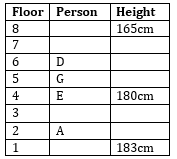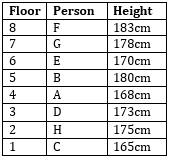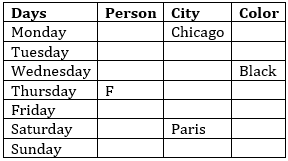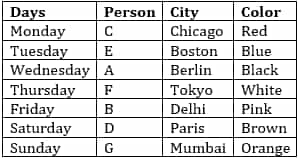Nowadays, the level of puzzles is increasing day by day and it takes a bit more time for solving because for each and every information you have to look at the screen. So, we suggest you following key points to approach puzzles.
- Read the Directions of question patiently, it is more important than solving questions.
- Express data on your rough sheet concisely and neatly.
- Try to find out the statements which consist of definite information.
- Make a series of statements which are linked to each other and sequence them.
Puzzles are generally of three types:
- Tabular Arrangement
- Scheduling
- Floor Based Arrangement
Now, let us take up some examples to explain you puzzle in a better way.
Tabular Arrangement Example
Directions: Study the following information carefully and answer the questions given below:
Sunit, Rohit, Sunny, Khushi, Manu, Tanu, and Ranu are seven friends traveling to three different cities – Jaipur, Ahmedabad, and Hyderabad – with at least two in each city. Each of them has a different profession- viz CA, CS, Lawyer, IAS, Pilot, IES and IRS but not necessarily in the same order.
- Manu’s profession is IRS and Rohit is travelling to Ahmedabad only with Manu.
- Those who travel to Jaipur are not CA and IAS.
- The one who is CS travels only with Ranu to Hyderabad.
- The one who is Pilot does not travel to the same city as Manu or Ranu.
- Sunit does not travel to Ahmedabad but he is an IES.
- Khushi and Tanu are travelling to the same city but Tanu is not Lawyer.
- The one who is IAS does not travel to Ahmedabad.
Solution:
Here we can see that statement 1 and statement 3 have definite information. We will start with these both statements.
From statement 1 and statement 3, it is clear that only two persons travel to Ahmedabad and Hyderabad. So, the remaining three persons will travel to Jaipur.
Now we will express our data concisely, we not need to scroll screen again and again.
So, from statement 1
Ahmedabad | Manu | IRS |
Rohit |
|
From statement 3
Hyderabad | Ranu |
|
| CS |
Now try to find out the statements which are related to the above definite statements.
In statement 2 and 8, it is mentioned that IAS does not travel to Ahmedabad and Jaipur. So, IAS definitely travel to Hyderabad. Only two persons are traveling to Hyderabad, CS is travelling with Ranu. Hence, Ranu must be an IAS.
Hyderabad | Ranu | IAS |
| CS |
From statement 5,
Sunit is an IES but he does not travel to Ahmedabad and Only two persons who are IAS and CS are travelling to Hyderabad. So, Sunit is travelling to Jaipur.
From statement 6,
Khushi and Tanu are travelling to the same city and they can only travel to Jaipur because already two-two persons are travelling to both Hyderabad and Ahmedabad.
It is also mentioned that Tanu is not a lawyer.
Jaipur | Sunit | IES |
Khushi |
| |
Tanu | Not Lawyer |
Now, the person only left is Sunny. So, he is travelling to Hyderabad.
Statement 4 says that Pilot is not travelling to the same city as Manu (Ahmedabad) and Ranu (Hyderabad). It means Pilot is travelling to Jaipur.
Again from statement 2, CA is not travelling to Jaipur. The profession of persons who are going to Hyderabad has been already derived. So, CA is travelling to Ahmedabad and that person is Rohit.
Now, let’s draw the complete table.
CITY | PERSONS | PROFESSION |
Ahmedabad | Manu | IRS |
Rohit | CA | |
Hyderabad | Ranu | IAS |
Sunny | CS | |
Jaipur | Sunit | IES |
Khushi |
| |
Tanu | Not lawyer |
Now only two professions and two persons are left which are Lawyer and Pilot, Khushi and Tanu. In statement 6 it is clearly mentioned that Tanu is not a lawyer, so he must be a Pilot and Khushi will be Lawyer. So, the Conclusion is
CITY | PERSONS | PROFESSION |
Ahmedabad | Manu | IRS |
Rohit | CA | |
Hyderabad | Ranu | IAS |
Sunny | CS | |
Jaipur | Sunit | IES |
Khushi | Lawyer | |
Tanu | Pilot |
Floor Based Arrangement Example
Directions: Study the following information carefully and answer the questions given below:
Eight persons A, B, C, D, E, F, G, and H live on an eight floors building. The lowermost floor is numbered 1 and the topmost floor is numbered 8. Their heights are i.e. 165cm, 168cm, 170cm, 173cm, 175cm, 178cm, 180cm and 183cm, but not necessarily in the same order. Both persons who live on the top floor and lowermost floor their height difference are maximums. Only one person lives between D and the one who is the shortest. One person lives between D and the one whose height is 180cm. G’s height is 178cm and lives just above E. One person lives between E and A and E lives above A. Not more than two persons are shorter than E and E’s height is not 168cm. One person lives between F and 170cm. One person lives between D and C. C’s height is not 180cm. Not more than two persons are taller than B. D is taller than A but shorter than H.Solution:
● Both persons who live on the top floor and lowermost floor their height difference are maximums so the one who is tallest and the one who is the shortest life either on 1st or 8th floor.
Case 1: Shortest person live on the 8th floor-
● Only one person lives between D and the one who is the shortest. D must live on the 6th floor.
● One person lives between D and the one whose height is 180cm. So the one whose height is 180cm lives on the 4th floor.
● G’s height is 178cm and lives just above E. One person lives between E and A and E lives above A. So, G must live on 5th floor, E lives on the 4th floor and A must live on the 2nd floor.
● Not more than two persons are shorter than E So E’s height cannot be more than 170cm so this case gets rejected. 
Case 2: Shortest person live on 1stfloor-
● Only one person lives between D and the one who is the shortest. D must live on the 3rd floor.
● One person lives between D and the one whose height is 180cm. So the one whose height is 180cm lives on the 5th floor.
● G’s height is 178cm and lives just above E. One person lives between E and A and E lives above A. So, G must live on 7th floor, E lives on the 6th floor and A must live on the 4th floor.
● Not more than two persons are shorter than E and E’s height is not 168cm and E also cannot be 165cm so E must be 170cm. 
● One person lives between F and 170cm. F must live on the 8th floor.
● One person lives between D and C. C’ height is not 180cm. So C must live on the 1st floor.
● Not more than two persons are taller than B. So 178cm and 183cm are already other persons so B’s height must be 180cm and lives on the 5th floor. H must be live on the 2nd floor.
● D is taller than A but shorter than H. D must be 173cm, A must be 168cm and H must be 175cm.
Here is the final table:  This is how you should solve the puzzle.
This is how you should solve the puzzle.
Scheduling Example
Solution:
Let's have a look at definite information first.
• F attends the meeting on Thursday.
• There is a difference of one day between F and the one who belongs to Paris. So, Either F will go on Saturday or Tuesday. Now, F attends the meeting before the one who belongs to Paris. So, The one who belongs to Paris attend the meeting on Saturday.
• Two persons attend the meeting between the one who belongs to Paris and the one who likes Black. So Wednesday –Black.
• One person attends the meeting between the one who likes Black and the one who belongs to Chicago. The one who belongs to Chicago attends the meeting one of the days before F. So Chicago-Monday. 
• B attends the meeting just before D and just after the one who belongs to Tokyo. The one who likes Orange attends the meeting after D. So F belongs to Tokyo, B-Friday, D-Saturday and Orange-Sunday.
• Two persons attend the meeting between the one who likes Orange and the one who likes White. So White-Thursday.
• One person attends the meeting between the one who likes White and the one who belongs to Boston. So Boston-Tuesday.
• C attends the meeting just before the one who belongs to Boston. So C-Monday.
• One person attends the meeting between C and A. So A-Wednesday.
• At least two persons attend the meeting between A and the one who belongs to Mumbai. So Mumbai-Sunday.
• The number of people attends the meeting before E is equal to after D. One person attends the meeting after D so E must attends the meeting on Tuesday. Then G must attend the meeting on Sunday.
• One person attends the meeting between G and the one who belongs to Delhi. So B-Delhi and A-Berlin.
• Two persons attend the meeting between the one who belongs to Berlin and the one who likes Brown. So D-Brown.
• The one who likes Red attends the meeting just before the one who likes Blue. So, C likes Red, E likes Blue and Rest B likes Pink.
Here is the final table: 
Make sure that you solve all the quizzes of Reasoning section. Attempt them regularly to strengthen your concepts.
If you have any doubts, please let us know in the comments!





Comments
write a comment